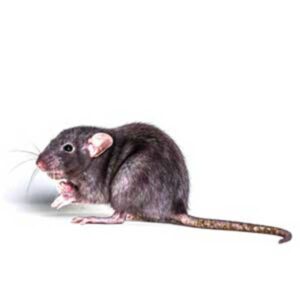 There exists a social stigma about rodents, which is why you may not hear much about this subject at the block party. However, muster up the courage to ask around and you’re sure to hear more than you want to know from a surprising number of your neighbors!
There exists a social stigma about rodents, which is why you may not hear much about this subject at the block party. However, muster up the courage to ask around and you’re sure to hear more than you want to know from a surprising number of your neighbors!
Palm rats, also known as “roof rats” commonly nest in palm trees, which is where the common name comes from. Due to the fact that they are excellent climbers, they are also known as roof rats. They are the biggest rodent pests in Louisiana.
What Kinds of Damage do Palm Rats Cause?
Palm rats cause damage primarily through gnawing, chewing or tearing with their teeth and paws. Indoors, these rodents can tear through insulation or gnaw on electrical wire, potentially short-circuiting electronic devices or even actually starting fires. Like other rodents, they will also eat any leftover food found in the kitchen.
Outdoors, palm rats can damage gardens by eating plants, fruits and vegetables. They will also climb into trash cans and feed on food debris. Further, they will chew on and wear down the sealant along roofs, which is often how they find their way into houses.
Signs of Roof Rats
How do you know if roof rats are present? Droppings, found around feeding areas, nesting sites or runways, are usually a telltale sign. Look out for signs of damage, such as teeth marks on food packaging, wooden structures, electrical wires or other household items.
Greasy smudging along your walls, beams, rafters and other fixtures could also be left by the oil and dirt on the bodies of rats as they move around the house and rub against surfaces. That’s not creepy or anything.
As most affected homeowners will tell you, the rodents’ noises are usually the biggest indicator; scraping, gnawing or squeaking can keep you up at night! You can hear the rats as they run around within the walls, ceilings or attics. Fun.
Other obvious signs include seeing runways and tracks. As rats repeatedly use the same path between their nest and food sources, they create tracks, which can appear as paths that are smooth and free of vegetation.
They will also leave footprints in the dust or mud. Rats can usually be easily spotted outdoors on trees, wires and fences.
How to Prevent Palm Rats (aka Roof Rats)
Have you decided you’d rather not host palm rats? Well, first things first: don’t feed them. Roof rats will feed on almost anything, including pet food and trash, in order to survive.
Make sure no pet food is left out overnight, including bird seed. Fill just enough for the day and clean up any excess before sunset. Store pet food in sealed, rat-proof containers.
Similarly, make sure any bulk foods are also sealed in this manner. Make sure trash cans are tightly covered. We’ve already established that rats are pretty gross, so you must pick up even dog feces immediately.
Palm Rat Removal
If dealing with palm rats hasn’t seemed like enough fun yet, here comes the best part. You must place snap traps and bait stations to eliminate rats that are already on your property, or to prevent more from entering.
It’s best to place a small amount of bait so that the rat will have to work at it to get it off, increasing the chances that the bait will trip successfully. Make sure the trap is set far away from pets and small children.
As rats are wary of new objects, leave the traps in the same location for at least a week before shifting its position. Alternatively, bait stations can be used as they allow you to place poison baits safely- without posing a hazard to non-target animals.
Bait stations provide a sheltered space for rats to feed. They can be placed in your yard, four feet or higher off the ground, near fruit trees, along rat paths, and close to wires that lead to house roofs and trees.
Of course, prior to this step you’ll want to seal your home properly so that a poisoned rat doesn’t die in your house, leaving a bad odor which is often difficult to remove.
Manicure landscape
Clean yards and gardens to ensure that there are fewer hiding places and feeding grounds for the rats, which deters them from entering your structures.
Rake fallen leaves from under trees and shrubbery, and prune fruit trees so that the ground under them is clear and visible. Store wood and lumber piles at least 18 inches above the ground and 12 inches away from walls.
Thick ground covers should be thinned. Keep palm trees trimmed, as rats love to nest in the skirts of old fronds, as well as in piles of debris and hollow trees.
Thin out bushes like oleanders and bougainvillea until you can see daylight through them. Oleanders are particularly attractive to these rats in the summer.
Harvest citrus and other fruit
Regularly harvest all fruit whether or not they are completely ripe. Trees that are in contact with other trees, houses, fences and power lines are especially prone to rat infestations. An idea for the extra produce during your infestation may be donating to local food banks.
Once the rats are under control or thoroughly eradicated you can enjoy your harvest, but you should still make it a habit to pick your fruit promptly and completely. Fortunately, it’s not usually necessary to remove the fruit trees from your property.
If you’re struggling with a palm rat infestation problem or even suspect you may have the beginnings of one, Ja-Roy Pest Control can help! Our rodent control experts will eradicate the rodents safely and effectively from your property with as little disruption to your life as possible. Call us today for a rodent-free tomorrow!
What are Palm Rats? in Southern Louisiana
Ja-Roy Pest Control Services is a local Pest Control and Extermination company helping homeowners and businesses with pest issues across Southern Louisiana.
